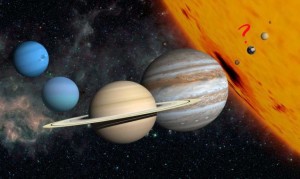When searching for planets like our own – those that have the potential to house life – astronomers look at very specific criteria. From the size of its star to whether or not the planet would fall into the thin band of space around its sun known as the ‘circumstellar habitable zone’, there are many things that scientists look at to ascertain whether or not a planet is likely to have given rise to life in the same way our own planet did.
 In the past year alone, over 700 planets have been found that meet the set criteria, with some looking far more promising than others, and with one in particular having a very similar mass and being an almost identical distance from its star as we are from our own.
In the past year alone, over 700 planets have been found that meet the set criteria, with some looking far more promising than others, and with one in particular having a very similar mass and being an almost identical distance from its star as we are from our own.
One of the main criteria that astronomers use to decide whether or not a planet would be suitable for life as we know it is how solid its land happens to be, as it is strongly believed that any life in the universe would need to be evolve near a firm surface. Now, astronomers have found a new planet that fits into the criteria that a celestial mass would need to house life. And it is a monster.
Mega
The planet, named Kepler-10c, is 17 times the size of the earth, orbiting a star that is very similar to our own. However, the star, located in the Draco constellation, is around twice as old as our own, meaning that if life had indeed thrived on this planet, the evolution process there may have started many millennia before our own.
The planet, which is extremely rocky, has been labelled a ‘mega-Earth’ and is the first of what astronomers believe could be an entirely new class of planet. Weighing as much as Neptune but being less than two-thirds of the size, it is thought that the planet must be predominantly formed from rock to be so heavy.
Mysteries still surround the planet, though. For example, with such a significant mass, the planet should have a huge gravitational pull, meaning that it should have ultimately become a gas giant, not unlike Jupiter. The current theory is that its formation was the result of a collision between two smaller, rocky planets, that had little gas surrounding them.
Differences
Whilst the planet was first detected by Kepler in 2011, it is only now that scientists have confirmed its mass, having had to wait to see how fast it was orbiting its star before they could calculate its mass. As such, it is only now that scientists have become confident that the planet must be made primarily of rock.
However, whilst scientists the world over have dubbed the planet a mega-Earth, its rocky surface may be the only feature that makes it similar to our home planet. Not only is its mass and size very different to ours, and not only do some speculate that it will have an atmosphere predominantly comprised of hydrogen and helium, but there may also be extreme pressures on the planet’s surface too. So whilst it is indeed rocky, and whilst that would indicate that life could thrive there, this is where the similarities with our own planet end.
Either way, Kepler-10c remains a very interesting and important discovery, showing us that there are new classes of planets out there to be found, if only we turn our astronomical telescopes towards them. As such, there are new discoveries just waiting to be made, ensuring that stargazing remains as much fun for the professionals as it is for amateurs.
Alan Holmes is a freelance writer and blogger. He regularly writes articles about physics and astronomy, using sites such as Sherwoods to stay up to date with all the latest industry news and developments.



Average Rating